
HOME
INTRO
SYMBOLS
ALMANAC
ECONOMY
GEOGRAPHY
STATE MAPS
PEOPLE
FORUM
NEWS
COOL SCHOOLS
STATE QUIZ
STATE LINKS
BOOK STORE
MARKETPLACE
GUESTBOOK
CONTACT US


Tweet
Double click on word for definition.
Missouri State Animal
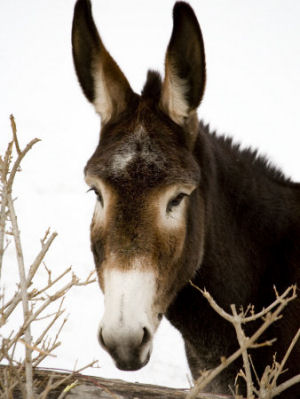
Missouri State Animal: Missouri Mule
Say Cheese! Photographs, prints and posters
To begin with, a mule is a cross between a female horse (mare) and a male donkey (stallion or jack).
Entwined in the history of Missouri, the mule maintains a broadly recognized special accommodation within the state. From the early 19th century to the early 20th century mules played a central role in the history of Missouri farming and land development. In 1870, Missouri was the largest mule-holding state in the nation. It would remain so until 1900.
Please take time to read about some of the history of this remarkable animal below.
According to Richard Flentge, in his book Mule Tack: How Missouri became the Official State of the Mule , we owe the final adoption of a bill, to name the Missouri mule the official state animal of Missouri, to military veteran Charles 'Woody' Woodford (1925-2007) and his wife Lois.
Unsuccessful efforts to name the mule the official state animal had been attempted before Woodford took up the cause. Evidently, the seemingly simple procedure to name the mule the official state animal of Missouri was not as simple as it might seem. In fact, legislation had been blocked because some legislators feared the mule would be confused with a donkey, a symbol of the Democratic Party.
When Woodford heard of this, he was distressed that the legislators were politicizing the recognition of a real icon of Missouri's history and a "fellow veteran."
Woodford, a member of Disabled American Veterans (DAV), Veterans of Foreign Wars (VFW) and American Legion Post 63, Cape Girardeau, decided to do something about the "real injustice to the state." [ 1 ]
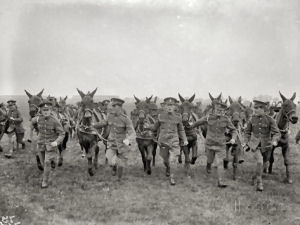
Missouri State Animal: Missouri Mule
Photographs, prints and posters
Woodford had enlisted in the U.S. Navy when he was 17. He served three years during World War II, two abroad in the Pacific theater and was discharged in 1945.
Woodford was onboard the USS Missouri when Japan surrendered to the United States on August 4, 1945, said Ken Ethridge, a VFW member. [ 5 ]
(Wylie 2A)
Following the war, he served as a sergeant in the Army National Guard before enlisting, in 1950, in the U.S. Air Force where he served for 21 years.
During his stints in the military he gained respect for the work of the Missouri mules that hauled military equipment, supplies and even troops in wartime. Mules had assisted military operations during the Mexican War, Civil War, Spanish-American War, two world wars and the Korean War.
In 1994, Woodford, with the assistance of another American Legion Post 63 veteran, John Yallaly, set out to promote adoption of the Missouri mule as Missouri's official state animal.
"The mule was a vet, just like us," Woodford said. "The American Legion seemed the right vehicle to do this." [ 2 ]
"We never lost a war a mule was involved in," said Woodford. [ 2 ]
(Scott 1)
In order to push the Missouri State Legislature into action and ensure passage of a final bill, Woodford embarked on a statewide calling campaign and tour to garner support for the Missouri mule as the official state animal. Tirelessly, he worked to recruit a broad coalition of backers so that the legislature would be forced to respond positively.
State Representative Jerry E. McBride was tapped to introduce the legislation honoring the Missouri mule. Rep. McBride took on the task and prefiled House Bill No. 84 on December 12, 1994.
House Bill No. 84 was introduced in the House on January 5, 1995. It became known as the "mule bill."
With thousands of veterans, academics, and the publishers of Western Mule and Mules and More magazines, proponents of the bill overwhelmed the House Committee on Tourism, Recreational and Cultural Affairs.
Testifying for the bill were: Representatives McBride and Kasten; Melvin Bradley, Retired College Professor; Ben Tennison, Publisher of the Western Mule Magazine; Charles Woodford, Member American Legion Post 63; Clyde Brownfield, Member American Legion Post 520, La Monte, Missouri; Col. Frank H. Duggins, Kemper Military School and College, Marshall, Missouri; Dr. Norris W. Preston, State Commander, American Legion, Moberly, Missouri; Bob Johnson, Central Missouri State University; Sue Cold, Publisher of Mules and More Magazine; and Jean Gay.
PROPONENTS: Supporters say Missouri hasn't given proper recognition to an animal that has long been identified with the state. Most Missourians, as well as people outside Missouri, believe the mule is the state animal. Supporters say Missouri has the finest mule heritage in the world. Missouri produced hundreds of thousands of mules earlier in this century. The Missouri Mule was honored as the best at the 1904 St. Louis World's Fair and in peak times some 500,000 or so mules were exported annually to other states and several countries.
Supporters say it is only fitting that an animal which has been so important in developing this state be honored as the official state animal. [ 3 ]

Missouri State Animal: Missouri Mule
Photographs, prints and posters
University of Missouri animal science professor emeritus Melvin Bradley was especially helpful to Woodford.
Bradley had become enamored with mules "as a barefoot farmer's boy working a mule team in the Missouri cornfields. ?I found that the mule has so much more personality than a horse. A mule is highly intelligent. He will outsmart you.'" [ 6 ]
A lifelong fascination with mules lead him to author the two-volume The Missouri Mule: His Origins and Times, Miniature and Hunting Mules of Missouri and found The Missouri Muleskinner's Society.
An expert on mules, he was able to provide extensive background on the animal along with a long list of attributes that would make it the perfect animal to represent the State of Missouri.
On February 16, 1995, the mule bill was passed by the State House of Representatives (139-11) and forwarded to the Senate for its consideration.
Approval by the Senate was all that was needed before the bill was forwarded to Governor Carnahan for his signature.
Carnahan said he "would look very favorably" on honoring the mule, recalling that "the first animal I ever rode" growing up in rural Shannon Counting was a mule. [ 4 ]
But, in early May, 2 1/2 months after its first reading, the bill looked to be threatened by a series of amendments that were being proposed.
There was concern among the bill sponsors. Two things could happen that might sabotage the mule bill.
An unfavorable amendment could jeopardize the entire bill by making it impassable in the Senate.
Also, even if an amendment succeeded in the Senate, the amended bill would have to be returned to the House for another round of voting where it could be rejected or even ignored, which was a real possibility as the final days of the current legislative session drew to a close.
Senator Harold Caskey proposed two amendments to the bill. The first amendment designated the Foxtrotter the official state horse and the second named Jesse James as Missouri's official state outlaw. Fortunately, Sen. Caskey withdrew his proposals after a short round of discussion.
Senator John Scott attempted to tack on an amendment to ban cockfighting in Missouri, but Senate President Pro Tem, James Mathewson ruled that Scott's amendment was "out of order."
Another amendment proposed adding square dancing as the official "American folk dance of the State of Missouri."
This amendment survived. A senate committee substitute, amended, was approved by the full Senate (29-4) on May 9 and sent back to the House. The House gave next-day approval.
The final bill was printed, signed by the Speaker of the House and the Senate President Pro Tem and forwarded to the Governor on May 18, 1995.
The Missouri mule was declared the official animal of the State of Missouri when Governor Melvin Eugene "Mel" Carnahan signed House Bill No. 84 on May 31, 1995.
With Carnahan's signature, the American folk dance of the State of Missouri was also declared along with the official state animal.
Missouri Law
The following information was excerpted from the Missouri Revised Statutes, Title 2, Chapter 10, Section 10.110.
TITLE II SOVEREIGNTY, JURISDICTION AND EMBLEMS
Chapter 10 State Emblems
Section 10.110
Official animal.
10.110. The Missouri Mule, known for its strength, hardiness, intelligence and even temper, is selected for and shall be known as the official animal of the state of Missouri.
(L. 1995 H.B. 84 & 98)
Sources...
[ 6 ] "Obituaries: Melvin Bradley." The Telegraph. Telegraph Media Group Limited, 24 Mar 2003. Web. 3 Dec 2013.
[ 5 ] Wylie, Peter. "Charles Woodford Dies: Veteran remembered as ?wonderful, dynamic?." Southeast Missourian [Cape Girardeau] 2 Jun 2007, 2A. Print.
[ 4 ] Charton, Scott. "Mules: Missouri state animal bill still alive in Capitol." Southeast Missourian [Cape Girardeau] 10 May 1995, 2A. Print.
[ 3 ] "Activity History for HB84." Missouri House of Representatives. State of Missouri, 31 May 1995. Web. 3 Dec 2013.
[ 2 ] Scott, Peggy. "Legion post: Missouri mule should be state animal." Southeast Missourian [Cape Girardeau] 4 Jun 1994, 1. Print.
[ 1 ] Flentge, Richard. Mule Tack: How Missouri became the Official State of the Mule. North Charleston, S.C.: On-Demand Publishing, LLC, 2013. Print.
"Charles Woodford." Southeast Missourian [Cape Girardeau] 2 Jun 2007, 2A. Print.
Rinehart, Samantha. "The Missouri Mule Cape native shares the story of the state's official animal in new book." Southeast Missourian. The Southeast Missourian, 28 Apr 2013. Web. 3 Dec 2013.
"Missouri General Assembly." Kansas City Star 11 May 1995, C4. Print.
Scott, Peggy. "Missouri mule project generating nationwide attention and support." Southeast Missourian [Cape Girardeau] 16 Sep 1994, 16. Print.
Moulton, Roy K. "Moulton is defender of the mule." Rochester Evening Journal and Post Express 18 Dec 1924, Editorial. Print.
"State Symbols of Missouri." Missouri Secretary of State. 2009. 7 April 2009
"Missouri Revised Statutes." Missouri General Assembly. 2009. 7 April 2009
Shearer, Benjamin F. and Barbara S. State Names, Seals, Flags and Symbols: A Historical Guide Third Edition, Revised and Expanded. Westport, Conn: Greenwood Press, 3 Sub edition, 2001.
Additional Information
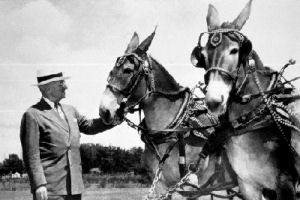
Retired President Harry Truman & Missouri Mules c.1955
Photo credit: University of Missouri
Photographs, prints and posters
Missouri's State Animal: Missouri Secretary of State: State Symbols of Missouri.
What is a Mule?: The American Donkey and Mule Society.
History of the Mule: American Mule Museum, Bishop, Calif.
History of Jacks and Mules in Missouri: Part of the "Missouri Agricultural History Series" by Lyndon Irwin, local history buff from Bois D'Arc, Missouri.
Mule Club: University of Missouri: College of Veterinary Medicine.
Mule Show: Missouri State University: 1904 St. Louis World's Fair.
The Missouri Mule: "Missouri Over There" blog, exploring Missouri's role in WWI.
The Missouri Mule: The Missouri mule in the mines from Historic Joplin.
Missouri Mule History Project Records :
Holdings of the Historical Society of Missouri.
:
Holdings of the Historical Society of Missouri.
Missouri Mules: State of the Ozarks: Missouri mules from bygone days to present times.
Equus caballus (Horse) Information and pictures from the University of Michigan Museum of Zoology's Animal Diversity Web.
Equus asinus (Ass, Donkey) Information and pictures from the University of Michigan Museum of Zoology's Animal Diversity Web.
Equus caballus Linnaeus, 1758: Integrated Taxonomic Information System (ITIS) Here you will find authoritative taxonomic information on plants, animals, fungi, and microbes of North America and the world.
Equus asinus Linnaeus, 1758: Integrated Taxonomic Information System (ITIS) Here you will find authoritative taxonomic information on plants, animals, fungi, and microbes of North America and the world.
Equus caballus (Horse): CalPhoto photographs. The Biodiversity Sciences Technology group (BSCIT), a part of the Berkeley Natural History Museums at the University of California, Berkeley.
Equus asinus (Ass, Donkey): CalPhoto photographs. The Biodiversity Sciences Technology group (BSCIT), a part of the Berkeley Natural History Museums at the University of California, Berkeley.
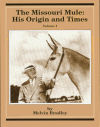
The Missouri Mule: Vol I
Melvin Bradley
State Animals: Complete list of official state animals.
More symbols & emblems: Complete list of official Missouri state symbols.
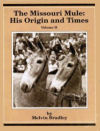
The Missouri Mule: Vol II
Melvin Bradley
The Missouri Mule: His Origins and Times, Vol I and Vol II, by Melvin Bradley. 247 pages (Vol. 1), 293 pages (Vol II) . Publisher: Univ of Missouri Extension Pubns; 1st edition (June 1993)
This 2-volume set is a comprehensive study of the origins, characteristics and uses of mules by the leading authority on the subject. Mr. Bradley, a University of Missouri professor of animal science from 1948 to 1990, probably knew more about the long-eared, broad-backed Missouri mule than anybody else.
Volume I covers information on the mule's origin, domestication, early uses; history; pioneer breeders; Missouri's first mules & the "creation" of the "Missouri Mule"; jack stock & breeding - where, when, & by whom; Krause & Old Beck, two mules that have given birth; mule breeding in Missouri; buying, feeding, & fitting mules for market; mule trading; working mules.
Volume II includes information on; showing & showmen; mule psychology; mules in education, rehabilitation, politics, parades; mules & horses in WW 2; demise & recovery; special people & special mules; modern uses of mules; the mule's image.
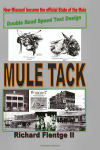
Mule Tack
Richard Flentge II
Mule Tack: How Missouri became the Official State of the Mule, by Richard Flentge II. 126 pages. Richard Flentge's new book describes how much of a fight it was to make the mule the official state animal.
A local storyteller uses an unexpected theme to combine the many tales of Cape Girardeau and Missouri history in his new book. In 1995, the Missouri Legislature and former governor Mel Carnahan adopted the mule as the official state animal. While it seems like a simple decision, and fitting choice for the predominantly rural state, Flentge said politics nearly prevented the animal from receiving that title.
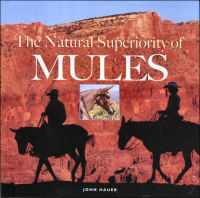
The Natural Superiority of Mules
by John Hauer
The Natural Superiority of Mules, by John Hauer. 160 pages. The Lyons Press (January 1, 2006) It all starts at birth: Baby mules are just a bit more precocious than other equine creatures. Of course, the most obvious physical advantage of the mule is those magnificent ears! The Natural Superiority of Mules is a collection of essays, articles, and stories in celebration of all the unique qualities of these remarkable hybrids. Full-color photographs accompanying the articles illustrate the grace, strength, agility, and especially, the lovely long ears of these fantastic and fascinating creatures.
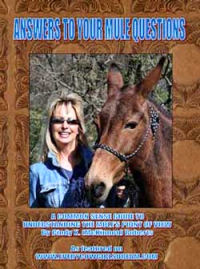
Answers To Your Mule Questions
by Cindy K. (McKinnon) Roberts
Answers To Your Mule Questions - A Common Sense Guide To Understanding The Mule's Point Of View, by Cindy K. McKinnon Roberts. 1ST edition (2007) Author/mule trainer Cindy K. Roberts helps mule owners to understanding the mule's point of view by offering her expertise and advice. Book offers wonderful insight on how to achieve a partnership with your mule along with information on: Young Mule Behavior Handling and Ground Manners Introducing New Herd Members Tacking Up and Saddling Vaccinations and Vet Phobia How To Determine If You Have Correct Saddle Fit Proper Bit Control Runaways Hard To Catch Mules Trailering Your Mule Kicking Mules.
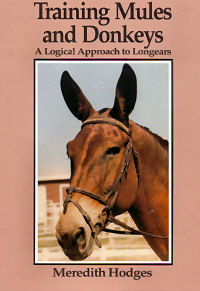
Training Mules and Donkeys
by Meredith Hodges
Training Mules and Donkeys: A Logical Approach to Longears, by Meredith Hodges. 329 pages. Alpine Publications; 1st edition (May 1993) Considered the first COMPLETE book on training mules, this is a 'no-resistance' training manual covering simple psychology and training techniques to help the trainer toward a more enjoyable and rewarding experience with their longears.
Mules Is Different: Everything You Wanted to Know about Longears, and More, by Les Sellnow. 224 pages. Eclipse Press; Ill edition (April 1, 2009) Mules is Different is written for the recreational rider who owns mules and for others who are considering buying a mule. Unlike previous books, which focus on training or anecdotal essays, Mules is Different fills the gap, covering all aspects of the unique needs of mules, from vet and farrier care and feeding to tack fitting and training. In addition, this comprehensive book features some of the fascinating, unique history of the mule.

